Info
Omschrijving
Frankfurt am Main is de grootste stad in de Duitse deelstaat Hessen en de vijfde stad van Duitsland. De stad ligt aan de oevers van de Main en telt 717.624 inwoners. De agglomeratie Frankfurt/Rhein-Main, waar Frankfurt het middelpunt van vormt en waar verder onder andere Mainz, Wiesbaden en Offenbach am Main toe behoren, telt meer dan 5,5 miljoen inwoners.
De stad werd voor het eerst vermeld als Frankonovurd aan het eind van de achtste eeuw. In de eeuwen daarna groeide de stad en in de hoge middeleeuwen verkreeg Frankfurt de status van vrije rijksstad. In de vrije stad Frankfort werden gedurende enige eeuwen de keizers van het Heilige Roomse Rijk gekozen en later ook gekroond. In de 19e eeuw was de stad de zetel van de Duitse Bond en de locatie van het Frankfurter Parlement, het eerste vrij gekozen Duitse parlement.
Frankfurt is uitgegroeid tot een Europese metropool. De stad heeft vrijwel alle kenmerken van een wereldstad. De stad is het voornaamste financiële centrum van Duitsland: de Deutsche Bundesbank en de Duitse beurs zijn er gevestigd, evenals de hoofdkantoren van verscheidene grote banken. Frankfurt staat daarnaast bekend als beurzenstad dankzij onder meer de Frankfurter Buchmesse, de jaarlijkse internationale uitgeversbeurs. Als zetel van de Europese Centrale Bank speelt de stad bovendien een grote rol in de Europese economie. Door de centrale ligging, het internationale vliegveld, het snelwegenknooppunt Frankfurter Kreuz en het treinstation is de stad een belangrijk verkeersknooppunt binnen Duitsland en Europa.
Kenmerkend voor Frankfurt is het moderne stadsbeeld: Frankfurt is een van de weinige Europese steden die worden gedomineerd door hoge wolkenkrabbers. Dit uit zich in de bijnaam Mainhattan.
Populaire Stadstour Bezienswaardigheden & Attracties
Frankfurt Cathedral
 Frankfurt Cathedral (Frankfurter Dom), officially Imperial Cathedral of Saint Bartholomew (Kaiserdom Sankt Bartholomäus) is a Roman Catholic Gothic church located in the centre of Frankfurt am Main, Germany. It is dedicated to Saint Bartholomew. It is the largest religious building in the city and a former collegiate church. Despite its common English name, it has never been a true cathedral (episcopal see), but is called the Kaiserdom (an “imperial great church” or imperial cathedral) or simply the Dom due to its importance as former election and coronation church of the Holy Roman Empire. As one of the major buildings of the Empire’s history, it was a symbol of national unity, especially in the 19th century. The present church building is the third church on the same site. Since the late 19th century, excavations have revealed buildings that can be traced back to the 7th century. The history is closely linked with the general history of Frankfurt and Frankfurt’s old town because the cathedral had an associated role as the religious counterpart of the Royal Palace in Frankfurt.
Frankfurt Cathedral (Frankfurter Dom), officially Imperial Cathedral of Saint Bartholomew (Kaiserdom Sankt Bartholomäus) is a Roman Catholic Gothic church located in the centre of Frankfurt am Main, Germany. It is dedicated to Saint Bartholomew. It is the largest religious building in the city and a former collegiate church. Despite its common English name, it has never been a true cathedral (episcopal see), but is called the Kaiserdom (an “imperial great church” or imperial cathedral) or simply the Dom due to its importance as former election and coronation church of the Holy Roman Empire. As one of the major buildings of the Empire’s history, it was a symbol of national unity, especially in the 19th century. The present church building is the third church on the same site. Since the late 19th century, excavations have revealed buildings that can be traced back to the 7th century. The history is closely linked with the general history of Frankfurt and Frankfurt’s old town because the cathedral had an associated role as the religious counterpart of the Royal Palace in Frankfurt.
Senckenberg Natural History Museum
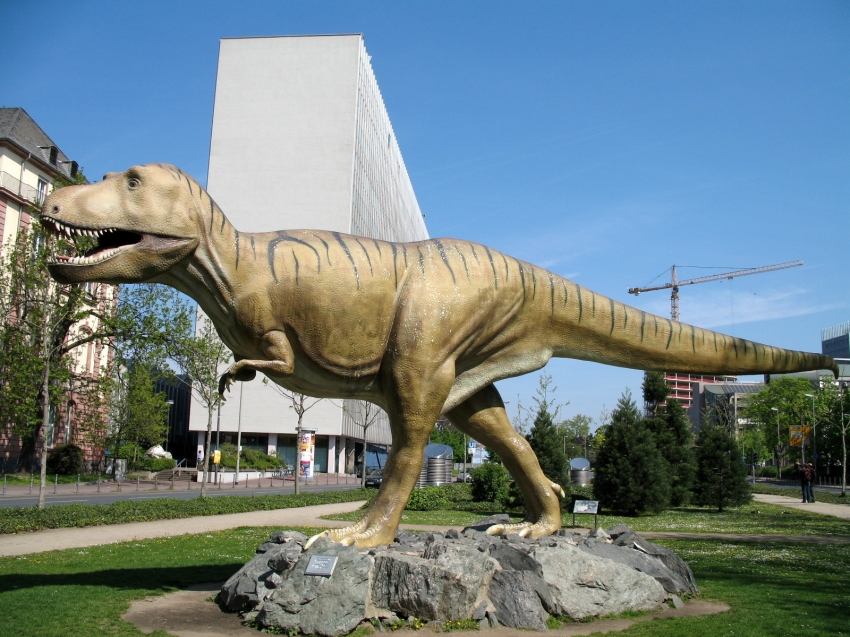 The Naturmuseum Senckenberg is a museum of natural history, located in Frankfurt am Main, It is the second largest of its type in Germany. The Senckenberg Museum is particularly popular with children, who enjoy the extensive collection of dinosaur fossils: Senckenberg boasts the largest exhibition of large dinosaurs in Europe. One notable exhibit is a dinosaur fossil with unique, preserved scaled skin. The museum contains a large and diverse collection of birds with 90,000 bird skins 5,050 egg sets 17,000 skeletons and 3,375 spirit specimens. In 2010, almost 517,000 people visited the museum. The building housing the Senckenberg Museum was erected between 1904 and 1907 outside of the center of Frankfurt in the same area as the Johann Wolfgang Goethe University, which was founded in 1914. The museum is owned and operated by the Senckenberg Nature Research Society, which began with an endowment by Johann Christian Senckenberg.
The Naturmuseum Senckenberg is a museum of natural history, located in Frankfurt am Main, It is the second largest of its type in Germany. The Senckenberg Museum is particularly popular with children, who enjoy the extensive collection of dinosaur fossils: Senckenberg boasts the largest exhibition of large dinosaurs in Europe. One notable exhibit is a dinosaur fossil with unique, preserved scaled skin. The museum contains a large and diverse collection of birds with 90,000 bird skins 5,050 egg sets 17,000 skeletons and 3,375 spirit specimens. In 2010, almost 517,000 people visited the museum. The building housing the Senckenberg Museum was erected between 1904 and 1907 outside of the center of Frankfurt in the same area as the Johann Wolfgang Goethe University, which was founded in 1914. The museum is owned and operated by the Senckenberg Nature Research Society, which began with an endowment by Johann Christian Senckenberg.
Palm Garden
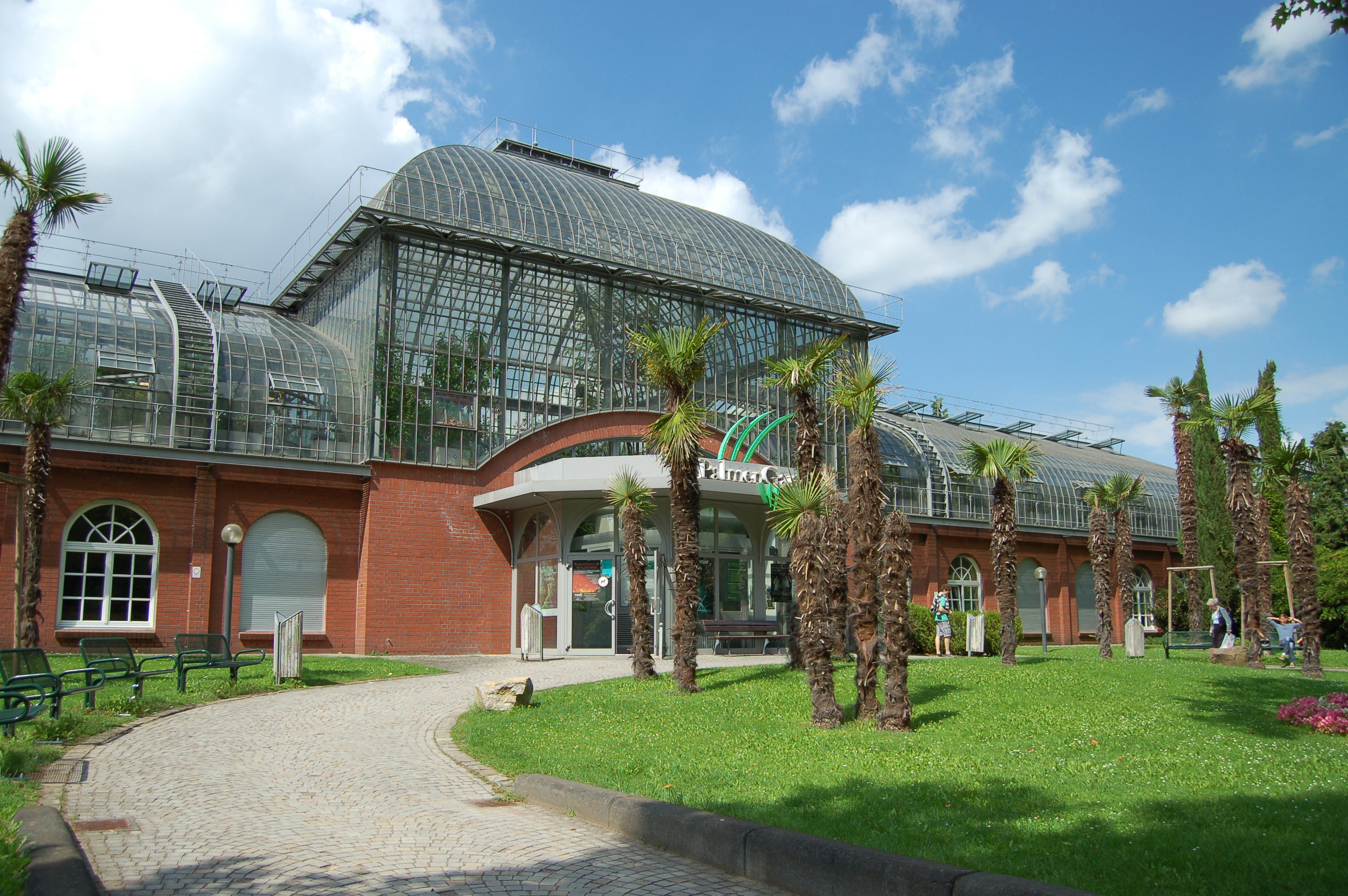 The Palmengarten is one of three botanical gardens in Frankfurt am Main, Germany. It is located in the Westend-Süd district. It covers a surface of 22 hectares. Like many public sites in Frankfurt, it was privately financed and implemented by the architect Heinrich Siesmayer. Work was completed in 1871 and opened to the public. One colorful visit was from the American entertainer Buffalo Bill who brought his Western show in 1890. In 1931, it was taken over by the city of Frankfurt but was later transferred to the American occupation authorities after World War II. When the Palmengarten was returned to the city’s hands in the sixties, a major reconstruction effort was begun. Halls destroyed in the war were redeveloped and expanded. In 1992 the reconstruction finished completely and the Palmengarten shined in its new form. Directly next to the area of the Palmengarten is the Frankfurt Botanical Garden, which formerly belonged to the biology department of Johann Wolfgang Goethe-Universität Frankfurt and is now administered by the Palmengarten.The botanical exhibits are organized according to their origin in free-air or climatized greenhouses, which also contain numerous tropical and subtropical plants.
The Palmengarten is one of three botanical gardens in Frankfurt am Main, Germany. It is located in the Westend-Süd district. It covers a surface of 22 hectares. Like many public sites in Frankfurt, it was privately financed and implemented by the architect Heinrich Siesmayer. Work was completed in 1871 and opened to the public. One colorful visit was from the American entertainer Buffalo Bill who brought his Western show in 1890. In 1931, it was taken over by the city of Frankfurt but was later transferred to the American occupation authorities after World War II. When the Palmengarten was returned to the city’s hands in the sixties, a major reconstruction effort was begun. Halls destroyed in the war were redeveloped and expanded. In 1992 the reconstruction finished completely and the Palmengarten shined in its new form. Directly next to the area of the Palmengarten is the Frankfurt Botanical Garden, which formerly belonged to the biology department of Johann Wolfgang Goethe-Universität Frankfurt and is now administered by the Palmengarten.The botanical exhibits are organized according to their origin in free-air or climatized greenhouses, which also contain numerous tropical and subtropical plants.
Römerberg
 Römerberg (Roman Mountain) is a public space in Frankfurt, Germany. It is located in front of the Römer building complex, seat of the Frankfurt city administration since the 15th century. As the site of numerous Imperial coronations, trade fairs and Christmas markets, the square is the historic heart of the medieval Altstadt (old town) and today a popular tourist destination. Paulsplatz, another historic square, is to the north. The Old St Nicholas Church and Historical Museum are to the south. Beyond that is Mainkai on the River Main. On the west side of the square is the reconstructed Römer medieval building. To the east is the Dom-Römer Project and beyond that is Frankfurt Cathedral. Römerberg is a major location for the outdoor Frankfurt Christmas Market.
Römerberg (Roman Mountain) is a public space in Frankfurt, Germany. It is located in front of the Römer building complex, seat of the Frankfurt city administration since the 15th century. As the site of numerous Imperial coronations, trade fairs and Christmas markets, the square is the historic heart of the medieval Altstadt (old town) and today a popular tourist destination. Paulsplatz, another historic square, is to the north. The Old St Nicholas Church and Historical Museum are to the south. Beyond that is Mainkai on the River Main. On the west side of the square is the reconstructed Römer medieval building. To the east is the Dom-Römer Project and beyond that is Frankfurt Cathedral. Römerberg is a major location for the outdoor Frankfurt Christmas Market.
Museumsufer
 Museumsufer is the name of a landscape of museums in Frankfurt, Hesse, Germany, lined up on both banks of the river Main or in close vicinity. The centre is the historic art museum Städel. The other museums were added, partly by transforming historic villas, partly by building new museums, in the 1980s by cultural politician Hilmar Hoffmann.
Museumsufer is the name of a landscape of museums in Frankfurt, Hesse, Germany, lined up on both banks of the river Main or in close vicinity. The centre is the historic art museum Städel. The other museums were added, partly by transforming historic villas, partly by building new museums, in the 1980s by cultural politician Hilmar Hoffmann.
Kleine Markthalle
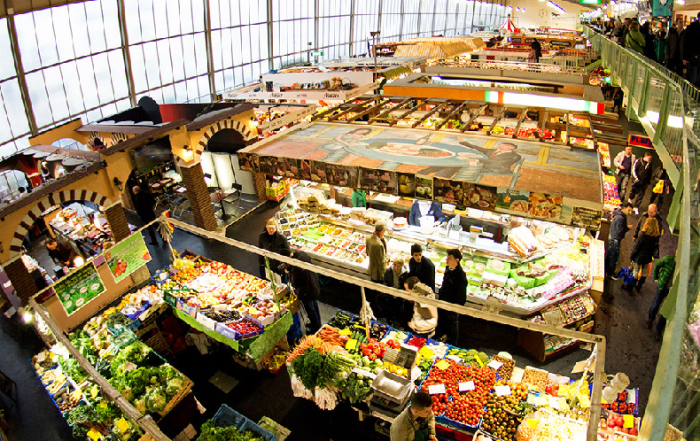 Markets are always a good place to get a feel for a city, and Frankfurt’s Kleinmarkthalle, where many locals shop daily, is no exception. The present hall dates from 1954, and its 1,500 square meters house 150 market stalls selling some of the finest foods in Germany. This is a good place to try out the famous Frankfurt “Green Sauce” (Frankfurter Grüne Soße), a traditional condiment made of seven herbs, sour cream, and egg. You can also savor local specialties like sausages, cheeses, and pastries.
Markets are always a good place to get a feel for a city, and Frankfurt’s Kleinmarkthalle, where many locals shop daily, is no exception. The present hall dates from 1954, and its 1,500 square meters house 150 market stalls selling some of the finest foods in Germany. This is a good place to try out the famous Frankfurt “Green Sauce” (Frankfurter Grüne Soße), a traditional condiment made of seven herbs, sour cream, and egg. You can also savor local specialties like sausages, cheeses, and pastries.
Museum of Modern Art
 The Museum für Moderne Kunst (Museum of Modern Art), or short MMK, in Frankfurt, Germany, was founded in 1981. The museum was designed by the Viennese architect Hans Hollein. Because of its triangular shape, it is called “piece of cake”. The core of the museum is the legacy of German collector Karl Ströher with some 65 works of Pop art and Minimalism. The manufacturer Ströher had originally bequeathed to his native city of Darmstadt on condition that a museum be built to house them. When funds for the project were not approved, Ströher’s heirs sold the choice ensemble to Frankfurt. Major artists since the 1950s from the Ströher Collection displayed, including Roy Lichtenstein, Andy Warhol, and George Segal, with his Jazz Combo. Between 1981 and 1987, the museum’s co-founder Peter Iden expanded the collection by adding works from the seventies and eighties. Later parts of the collection have been amassed by the museum’s first director, Jean-Christophe Ammann. In 2006 the Museum für Moderne Kunst, along with the Kunstmuseum Liechtenstein and the Kunstmuseum St. Gallen, acquired the private collection of Cologne art dealer Rolf Ricke, comprising works by Richard Artschwager, Bill Bollinger, Donald Judd, Gary Kuehn, und Steven Parrino. Today, the permanent collection includes over 4,500 works of international art, ranging from the 1960s to the present.
The Museum für Moderne Kunst (Museum of Modern Art), or short MMK, in Frankfurt, Germany, was founded in 1981. The museum was designed by the Viennese architect Hans Hollein. Because of its triangular shape, it is called “piece of cake”. The core of the museum is the legacy of German collector Karl Ströher with some 65 works of Pop art and Minimalism. The manufacturer Ströher had originally bequeathed to his native city of Darmstadt on condition that a museum be built to house them. When funds for the project were not approved, Ströher’s heirs sold the choice ensemble to Frankfurt. Major artists since the 1950s from the Ströher Collection displayed, including Roy Lichtenstein, Andy Warhol, and George Segal, with his Jazz Combo. Between 1981 and 1987, the museum’s co-founder Peter Iden expanded the collection by adding works from the seventies and eighties. Later parts of the collection have been amassed by the museum’s first director, Jean-Christophe Ammann. In 2006 the Museum für Moderne Kunst, along with the Kunstmuseum Liechtenstein and the Kunstmuseum St. Gallen, acquired the private collection of Cologne art dealer Rolf Ricke, comprising works by Richard Artschwager, Bill Bollinger, Donald Judd, Gary Kuehn, und Steven Parrino. Today, the permanent collection includes over 4,500 works of international art, ranging from the 1960s to the present.
Hauptwache
 The Hauptwache (Main Guardroom) is a central point of Frankfurt am Main and is one of the most famous plazas (An der Hauptwache) in the city. The original name Schillerplatz was superseded in the early 1900s. It lies to the west of Konstablerwache with both squares linked by the Zeil, the central shopping area of the city.
The Hauptwache (Main Guardroom) is a central point of Frankfurt am Main and is one of the most famous plazas (An der Hauptwache) in the city. The original name Schillerplatz was superseded in the early 1900s. It lies to the west of Konstablerwache with both squares linked by the Zeil, the central shopping area of the city.
Goethe House and Museum
 The Goethe House is a writer’s house museum in the Innenstadt district of Frankfurt am Main, Germany. The original building was the family residence of the Goethe family, most notably Johann Wolfgang von Goethe, until 1795. Johann Wolfgang was himself born here in 1749 to his parents, Johann Caspar Goethe, a lawyer, and Katherine Elisabeth Textor, daughter of the mayor (Bürgermeister) of Frankfurt. Johann Wolfgang lived here along with his sister Cornelia until 1765, aged sixteen, when he moved to Leipzig to study law, returning sporadically thereafter.
The Goethe House is a writer’s house museum in the Innenstadt district of Frankfurt am Main, Germany. The original building was the family residence of the Goethe family, most notably Johann Wolfgang von Goethe, until 1795. Johann Wolfgang was himself born here in 1749 to his parents, Johann Caspar Goethe, a lawyer, and Katherine Elisabeth Textor, daughter of the mayor (Bürgermeister) of Frankfurt. Johann Wolfgang lived here along with his sister Cornelia until 1765, aged sixteen, when he moved to Leipzig to study law, returning sporadically thereafter.
Zoo Frankfurt
 The Frankfurt Zoological Garden is the zoo of Frankfurt, Germany. It features over 4,500 animals of more than 510 species on more than 11 hectares. The zoo was founded in 1858 and is the second oldest Zoo in Germany, after Berlin Zoological Garden. It lies in the eastern part of the Innenstadt (inner city). Bernhard Grzimek was director of the zoo after World War II from 1945 until 1974. The Frankfurt Zoological Society (FZS) was founded in 1858 by citizens of Frankfurt to establish the Zoological Garden, which it operated until the First World War. The city council then assumed responsibility for the zoo until 1950, when the FZS again became the zoo’s development association.
The Frankfurt Zoological Garden is the zoo of Frankfurt, Germany. It features over 4,500 animals of more than 510 species on more than 11 hectares. The zoo was founded in 1858 and is the second oldest Zoo in Germany, after Berlin Zoological Garden. It lies in the eastern part of the Innenstadt (inner city). Bernhard Grzimek was director of the zoo after World War II from 1945 until 1974. The Frankfurt Zoological Society (FZS) was founded in 1858 by citizens of Frankfurt to establish the Zoological Garden, which it operated until the First World War. The city council then assumed responsibility for the zoo until 1950, when the FZS again became the zoo’s development association.
Eschenheimer Tower
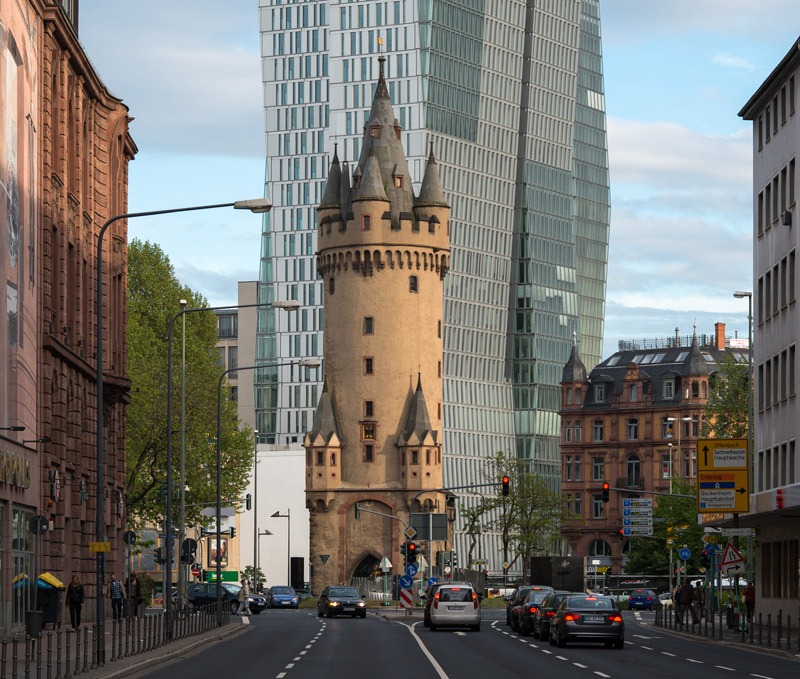 Eschenheimer Turm (Eschenheim Tower) was a city gate, part of the late-medieval fortifications of Frankfurt am Main, and is a landmark of the city. The tower, which was erected at the beginning of the fifteenth century, is at once the oldest and most unaltered building in the largely reconstructed Frankfurter Neustadt (new town), now better known as the Frankfurt-Innenstadt (city center).
Eschenheimer Turm (Eschenheim Tower) was a city gate, part of the late-medieval fortifications of Frankfurt am Main, and is a landmark of the city. The tower, which was erected at the beginning of the fifteenth century, is at once the oldest and most unaltered building in the largely reconstructed Frankfurter Neustadt (new town), now better known as the Frankfurt-Innenstadt (city center).
Alte Oper
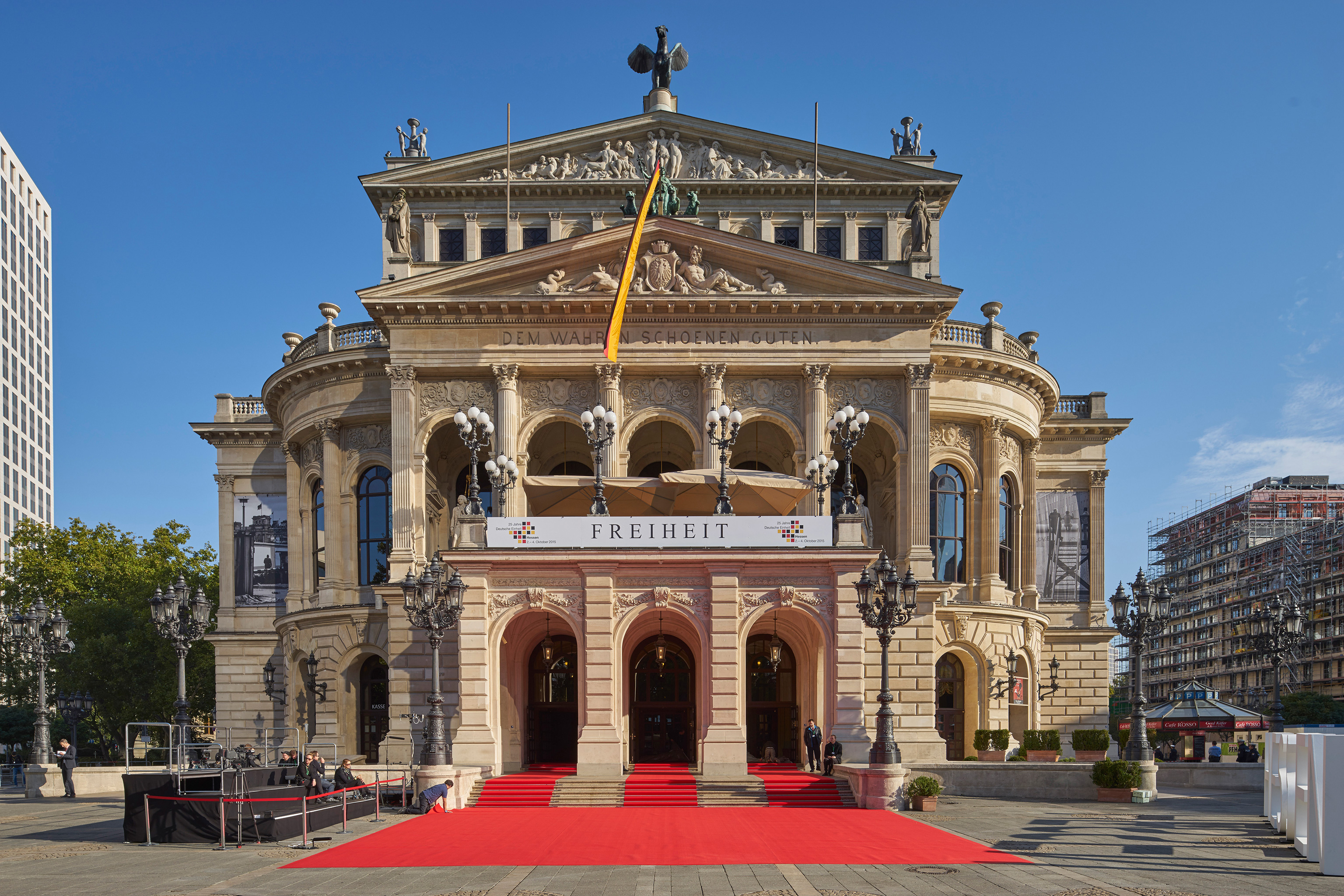 The original opera house in Frankfurt is now the Alte Oper (Old Opera), a concert hall and former opera house in Frankfurt am Main, Germany. It was inaugurated in 1880 but destroyed by bombs in 1944. It was rebuilt, slowly, in the 1970s, opening again in 1981. Many important operas were performed for the first time in Frankfurt, including Carl Orff’s Carmina Burana in 1937. The square in front of the building is known as Opernplatz (Opera Square). The Alte Oper is located in the inner city district, Innenstadt, within the banking district Bankenviertel. Frankfurt Opera is now in a modern building nearby, completed in 1951, which it shares with a theatre company.
The original opera house in Frankfurt is now the Alte Oper (Old Opera), a concert hall and former opera house in Frankfurt am Main, Germany. It was inaugurated in 1880 but destroyed by bombs in 1944. It was rebuilt, slowly, in the 1970s, opening again in 1981. Many important operas were performed for the first time in Frankfurt, including Carl Orff’s Carmina Burana in 1937. The square in front of the building is known as Opernplatz (Opera Square). The Alte Oper is located in the inner city district, Innenstadt, within the banking district Bankenviertel. Frankfurt Opera is now in a modern building nearby, completed in 1951, which it shares with a theatre company.

